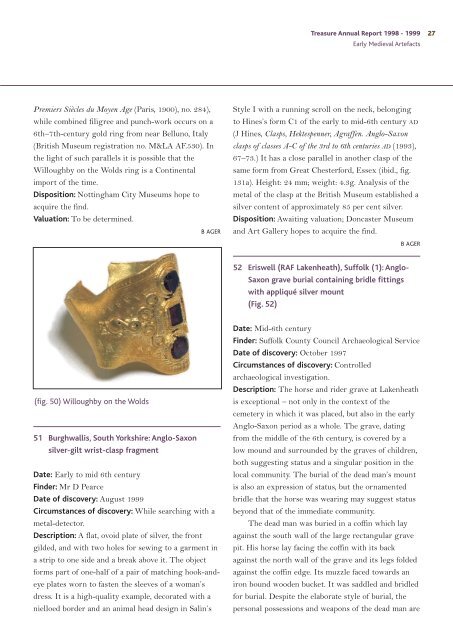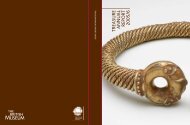Treasure Annual Report 1998-1999 - Portable Antiquities Scheme
Treasure Annual Report 1998-1999 - Portable Antiquities Scheme
Treasure Annual Report 1998-1999 - Portable Antiquities Scheme
Create successful ePaper yourself
Turn your PDF publications into a flip-book with our unique Google optimized e-Paper software.
Premiers Siècles du Moyen Age (Paris, 1900), no. 284),<br />
while combined filigree and punch-work occurs on a<br />
6th–7th-century gold ring from near Belluno, Italy<br />
(British Museum registration no. M&LA AF.530). In<br />
the light of such parallels it is possible that the<br />
Willoughby on the Wolds ring is a Continental<br />
import of the time.<br />
Disposition: Nottingham City Museums hope to<br />
acquire the find.<br />
Valuation: To be determined.<br />
(fig. 50) Willoughby on the Wolds<br />
51 Burghwallis, South Yorkshire: Anglo-Saxon<br />
silver-gilt wrist-clasp fragment<br />
B AGER<br />
Date: Early to mid 6th century<br />
Finder: Mr D Pearce<br />
Date of discovery: August <strong>1999</strong><br />
Circumstances of discovery: While searching with a<br />
metal-detector.<br />
Description: A flat, ovoid plate of silver, the front<br />
gilded, and with two holes for sewing to a garment in<br />
a strip to one side and a break above it. The object<br />
forms part of one-half of a pair of matching hook-andeye<br />
plates worn to fasten the sleeves of a woman’s<br />
dress. It is a high-quality example, decorated with a<br />
nielloed border and an animal head design in Salin’s<br />
<strong>Treasure</strong> <strong>Annual</strong> <strong>Report</strong> <strong>1998</strong> - <strong>1999</strong> 27<br />
Early Medieval Artefacts<br />
Style I with a running scroll on the neck, belonging<br />
to Hines’s form C1 of the early to mid-6th century AD<br />
(J Hines, Clasps, Hektespenner, Agraffen. Anglo-Saxon<br />
clasps of classes A-C of the 3rd to 6th centuries AD (1993),<br />
67–73.) It has a close parallel in another clasp of the<br />
same form from Great Chesterford, Essex (ibid., fig.<br />
131a). Height: 24 mm; weight: 4.3g. Analysis of the<br />
metal of the clasp at the British Museum established a<br />
silver content of approximately 85 per cent silver.<br />
Disposition: Awaiting valuation; Doncaster Museum<br />
and Art Gallery hopes to acquire the find.<br />
52 Eriswell (RAF Lakenheath), Suffolk (1): Anglo-<br />
Saxon grave burial containing bridle fittings<br />
with appliqué silver mount<br />
(Fig. 52)<br />
B AGER<br />
Date: Mid-6th century<br />
Finder: Suffolk County Council Archaeological Service<br />
Date of discovery: October 1997<br />
Circumstances of discovery: Controlled<br />
archaeological investigation.<br />
Description: The horse and rider grave at Lakenheath<br />
is exceptional – not only in the context of the<br />
cemetery in which it was placed, but also in the early<br />
Anglo-Saxon period as a whole. The grave, dating<br />
from the middle of the 6th century, is covered by a<br />
low mound and surrounded by the graves of children,<br />
both suggesting status and a singular position in the<br />
local community. The burial of the dead man’s mount<br />
is also an expression of status, but the ornamented<br />
bridle that the horse was wearing may suggest status<br />
beyond that of the immediate community.<br />
The dead man was buried in a coffin which lay<br />
against the south wall of the large rectangular grave<br />
pit. His horse lay facing the coffin with its back<br />
against the north wall of the grave and its legs folded<br />
against the coffin edge. Its muzzle faced towards an<br />
iron bound wooden bucket. It was saddled and bridled<br />
for burial. Despite the elaborate style of burial, the<br />
personal possessions and weapons of the dead man are





